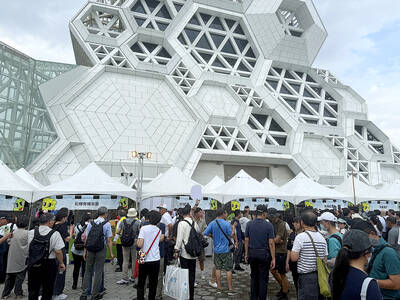An enormous glass vase containing roughly one hundred wine corks tastefully adorns the entrance of J.W. Teres, the recently opened upscale Bulgarian restaurant located in an alley across the street from the Far Eastern Plaza Hotel. For Krastyu Nedyalkov, who said he drank the contents of every bottle, it is a testament to his love of wine and a trophy indicating his tolerance for the tipple.
“My grandfather gave me my first drink at age 2,” Nedyalkov, whose family has been making wine for 400 years, announced with beguiling Balkan swagger. “I like to drink ... and I can drink a lot.”
The manager, chef and all-around spinner of yarns constantly reminded me that Bulgarians invented wine (of which the restaurant stocks 84 varieties) as well as yogurt — the latter, a hard-to-find ingredient that goes into many of his homemade dishes.
For all his Dionysian posturing, Nedyalkov has created a dining space that is Apollonian in its attention to detail. From the custom-made leather booth in the semi-private room and old-world chic of its sturdy tables and plush chairs, to the crystal wine glasses below the marble-topped bar that stocks a selection of whisky and Bulgarian liqueurs, this lounge bar cum bistro with its cornice finishing and handsomely framed modernist prints is poetically arranged to transport diners to Sofia, if only for a few hours. The only thing missing was flowers.
“This morning’s market didn’t have anything fresh,” Nedyalkov said, somewhat sheepishly.
Nedyalkov’s fastidious approach to detail translates to the food. There were three Bulgarian standards that I wanted to try: tarator (NT$180), a cold soup made with yogurt, cucumber, garlic and dill; kiopoolu (NT$280), an eggplant dip; and zucchini with garlic yogurt (NT$250). I ended up going with the latter two, but substituted lentil soup (NT$160) for the tarator.
Every bite of the kiopoolu made me pause. Eggplant, roast pepper, garlic, olive oil and herbs were mulched together and formed into a fragrant mound that was topped with five cubes of feta cheese, one for each of the tomato wedges that accompanied it.
Nedyalkov says he makes the yogurt served at Teres, and the blanket of the viscous substance that covered the baked zucchini slices was distinctive for its tanginess and subtle garlic flavor. The soup, a mixture of green lentils, carrot and onion in a light tomato broth, arrived with warm grain bread. It didn’t make a deep impression and I somewhat regretted not going with my earlier choice.
I had also originally planned to order either the caprese salad (NT$250) or the shopska salad (NT$270), of tomato, cucumber, pepper and onion topped with grated feta and dill pesto. I decided against both after noticing that the grilled lamb (NT$520) is served on a plate with sliced cucumber and tomato and topped with feta.
Cooked to perfection (medium rare), the lamb possessed a slightly mesquite aroma and was lean and juicy, the strong and salty cheese balancing nicely with the delicate flavor of the meat.
J.W. Teres is a dining experience that requires time to enjoy. As the majority of the dishes are made from scratch, expect to spend 90 minutes for dinner. Meanwhile, Nedyalkov will draw on his considerable experience to patiently explain which wine best accompanies each dish.

Following the shock complete failure of all the recall votes against Chinese Nationalist Party (KMT) lawmakers on July 26, pan-blue supporters and the Chinese Communist Party (CCP) were giddy with victory. A notable exception was KMT Chairman Eric Chu (朱立倫), who knew better. At a press conference on July 29, he bowed deeply in gratitude to the voters and said the recalls were “not about which party won or lost, but were a great victory for the Taiwanese voters.” The entire recall process was a disaster for both the KMT and the Democratic Progressive Party (DPP). The only bright spot for

Water management is one of the most powerful forces shaping modern Taiwan’s landscapes and politics. Many of Taiwan’s township and county boundaries are defined by watersheds. The current course of the mighty Jhuoshuei River (濁水溪) was largely established by Japanese embankment building during the 1918-1923 period. Taoyuan is dotted with ponds constructed by settlers from China during the Qing period. Countless local civic actions have been driven by opposition to water projects. Last week something like 2,600mm of rain fell on southern Taiwan in seven days, peaking at over 2,800mm in Duona (多納) in Kaohsiung’s Maolin District (茂林), according to

Aug. 11 to Aug. 17 Those who never heard of architect Hsiu Tse-lan (修澤蘭) must have seen her work — on the reverse of the NT$100 bill is the Yangmingshan Zhongshan Hall (陽明山中山樓). Then-president Chiang Kai-shek (蔣介石) reportedly hand-picked her for the job and gave her just 13 months to complete it in time for the centennial of Republic of China founder Sun Yat-sen’s birth on Nov. 12, 1966. Another landmark project is Garden City (花園新城) in New Taipei City’s Sindian District (新店) — Taiwan’s first mountainside planned community, which Hsiu initiated in 1968. She was involved in every stage, from selecting

The latest edition of the Japan-Taiwan Fruit Festival took place in Kaohsiung on July 26 and 27. During the weekend, the dockside in front of the iconic Music Center was full of food stalls, and a stage welcomed performers. After the French-themed festival earlier in the summer, this is another example of Kaohsiung’s efforts to make the city more international. The event was originally initiated by the Japan-Taiwan Exchange Association in 2022. The goal was “to commemorate [the association’s] 50th anniversary and further strengthen the longstanding friendship between Japan and Taiwan,” says Kaohsiung Director-General of International Affairs Chang Yen-ching (張硯卿). “The first two editions